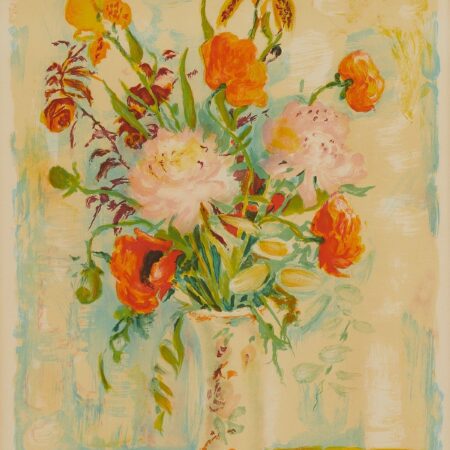
Le Pho (1907-2001). Oil on canvas depicting two women among plants. Signed along the lower left.
Provenance: Wally Findlay Galleries.
Biography:
Le Pho was born in Vietnam in 1907. As a child, he was constantly finding opportunities to make art. As the son of the Viceroy of Tonkin, he had the opportunity to study art at the newly established Ecole des Beaux-Arts in Hanoi under Victor Tardieu (1870-1937), a well-respected French painter. In 1931, he traveled to France with Tardieu, where he studied at the Ecole des Beaux-Arts in Paris on a scholarship. He then traveled to Italy to do research, also visiting the Netherlands and Belgium in his tour of Europe.
After returning to Vietnam, Le Pho became a professor at the Ecole des Beaux-Arts in Hanoi. During his professorship, he decided to continue his education by making trips to China to study and make art. While in China, he studied traditional Chinese sculpture, visited museums, and even had the opportunity to paint the Emperor and Empress.
In 1937, he was sent to Paris to work on the Indochina Pavilion at the International Exposition of Art and Technology in Modern Life. He stayed in France after the Exposition, where he found great success as an artist. His first solo exhibition was in 1938, and soon after, his work began getting international exposure. His works were widely distributed, particularly in the United States because of an exclusive contract he signed in 1964 with Wally Findlay Galleries, an American company.
Despite his expatriate status, Le Pho kept close ties to his homeland. He was active in the Vietnamese community in Paris, and worked with Vietnamese dignitaries and intellectuals to advocate for better treatment of the colonized Vietnamese people. His ties to his homeland are also evident in his subject matter. His paintings featured women and flowers, which he depicted in ways influenced by Vietnamese traditions and aesthetics.
This painting is an excellent example of these major themes of Le Pho’s work. The present work was painted during his Findlay Period, which is associated with his representation by Wally Findlay Galleries from 1963 to his death in 2001. During this stylistic period, Le Pho drew inspiration from his life-long admiration for Henri Matisse and created bright and colorful paintings. The present work features an idyllic scene with several green leafy plants scattered throughout the composition. Two women are standing in the center with another barely visible to the left. The main figure wears a soft coral colored robe that beautifully echos the other woman’s shawl. She wears a cerulean blue robe wonderfully accenting the rug beneath her. The artist’s choice of colors skillfully creates a harmonious composition that helps draw the viewer into the scene.
Sight: height: 38 1/2 in x width: 25 in.
Framed: height: 46 1/2 in x width: 33 in.
$55,000



